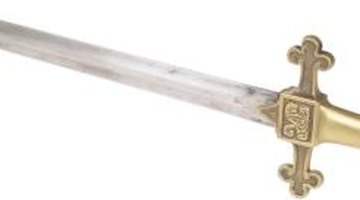One of Shakespeare's most famous plays, "Hamlet" is the story of a young Danish prince trapped in a web of deceit and murder as an epic power struggle plays out in his small kingdom. The play has influenced countless other writers and been the subject of various cinematic interpretations and those staging a production of "Hamlet" will require various props to tell the tragic tale.
Skull

In one of the most famous and parodied scenes from Hamlet, a gravedigger unearths the skull of Yorick, a deceased court jester and once friend of the prince. Hamlet is moved to sorrow by the sight of the skull and delivers a dramatic soliloquy beginning with "Alas, poor Yorick," as he holds the remains of his acquaintance in his hand. A stage production of "Hamlet" will require a prop skull for the scene, preferably one that has been given an aged, distressed look to mimic the appearance bones would have after being buried.
Coffin

One of the most famous characters in all Shakespearean literature, Ophelia is a tragic figure whose suicide by drowning has been the subject of many works of art. After taking her own life, the young Danish noblewoman is buried in a ceremony after Hamlet witnesses the procession of her coffin and argues that she receive a Christian burial as it is placed in the ground. However, she is denied such rites for committing suicide and Hamlet's mother throws petals onto her casket. A simple coffin as well as flower petals will be needed for the scene which will need to be placed into a recess on the stage to simulate burial in the ground.
- One of the most famous characters in all Shakespearean literature, Ophelia is a tragic figure whose suicide by drowning has been the subject of many works of art.
- After taking her own life, the young Danish noblewoman is buried in a ceremony after Hamlet witnesses the procession of her coffin and argues that she receive a Christian burial as it is placed in the ground.
Wine Goblet

"Hamlet" is a play with much treachery , its characters scheming and plotting to murder one another in a bid for power. In one of the last scenes of the play, the character of Horatio attempts to trick Hamlet into drinking poisoned wine by offering him a toast, a veiled attempt at killing the young prince. For the scene, a goblet and possibly a flagon of wine will be needed, depending on whether the director chooses to have Horatio pour the tainted beverage in view of the audience.
Swords

Unsurprisingly, for a play written hundreds of years ago, swords abound in Hamlet. Many characters carry them as a matter of course and several parts of the play feature them prominently. For instance, near the end of the story, Hamlet engages in a duel with another character, Laertes. Shortly thereafter, Hamlet stabs the character of Claudius with a sword which has been dipped in poison and was meant to kill Hamlet.
- Unsurprisingly, for a play written hundreds of years ago, swords abound in Hamlet.
- For instance, near the end of the story, Hamlet engages in a duel with another character, Laertes.
